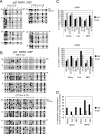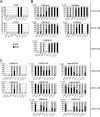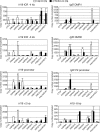CTCF is the master organizer of domain-wide allele-specific chromatin at the H19/Igf2 imprinted region
- PMID: 18039862
- PMCID: PMC2223393
- DOI: 10.1128/MCB.01361-07
CTCF is the master organizer of domain-wide allele-specific chromatin at the H19/Igf2 imprinted region
Abstract
A paternally methylated imprinting control region (ICR) directs allele-specific expression of the imprinted H19 and Igf2 genes. CTCF protein binding in the ICR is required in the maternal chromosome for insulating Igf2 from the shared enhancers, initiation of the H19 promoter transcription, maintaining DNA hypomethylation, and chromosome loop formation. Using novel quantitative allele-specific chromatin immunoprecipitation-single-nucleotide primer extension assays, we measured the chromatin composition along the H19/Igf2 imprinted domain in cells with engineered mutations at the four ICR-CTCF binding sites. Abolishing CTCF binding in the ICR reduced normally maternal allele-specific H3K9 acetylation and H3K4 methylation at the H19 ICR and promoter/gene body and maternal allele-specific H3K27 trimethylation at the Igf2 P2 promoter and Igf2 differentially methylated regions (DMRs). Paternal H3K27 trimethylation and macroH2A1 became biallelic in the mutant cells at the H19 promoter while paternal H3K9 acetylation and H3K4 methylation became biallelic at the Igf2 DMRs. We provide evidence that CTCF is the single major organizer of allele-specific chromatin composition in this domain. This finding has important implications: (i) for mechanisms of insulation since CTCF regulates chromatin at a distance, involving repression by H3K27 trimethylation at the Igf2 locus independently of repression by DNA hypermethylation; and (ii) for mechanisms of genomic imprinting since point mutations of CTCF binding sites cause domain-wide "paternalization" of the maternal allele's chromatin composition.
Figures








References
-
- Bartolomei, M. S., A. L. Webber, M. E. Brunkow, and S. M. Tilghman. 1993. Epigenetic mechanisms underlying the imprinting of the mouse H19 gene. Genes Dev. 71663-1673. - PubMed
-
- Bell, A. C., and G. Felsenfeld. 2000. Methylation of a CTCF-dependent boundary controls imprinted expression of the Igf2 gene. Nature 405482-485. - PubMed
-
- Bell, A. C., A. G. West, and G. Felsenfeld. 1999. The protein CTCF is required for the enhancer blocking activity of vertebrate insulators. Cell 98387-396. - PubMed
-
- Brannan, C. I., and M. S. Bartolomei. 1999. Mechanisms of genomic imprinting. Curr. Opin. Genet. Dev. 9164-170. - PubMed
-
- Choo, J. H., J. D. Kim, J. H. Chung, L. Stubbs, and J. Kim. 2006. Allele-specific deposition of macroH2A1 in imprinting control regions. Hum. Mol. Genet. 15717-724. - PubMed
Publication types
MeSH terms
Substances
Grants and funding
LinkOut - more resources
Full Text Sources
Other Literature Sources
Molecular Biology Databases
Miscellaneous
